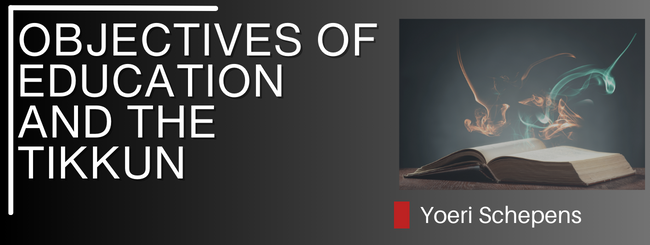Analysis and Synthesis: Two Fundamental Operations of the Mind
Unfortunately, most people, when they learn, allow the information to lie in their minds as a fragment. It’s a fragment, little analyzed, without much structure. How well do you understand something when It’s a fragment? This is the problem, that most peoples’ understanding of information, whatever it is, Torah or anything else, lies in the fact that it’s a fragment and remains so.
Fragmented ideas cannot offer understanding. What RaMChaL did was to include an Introduction to his sefer–book making clear that it’s not about hashkafa—outlook, philosophy; it’s about methodology of thinking. He emphasizes that, if you want to understand something, you cannot understand it being a fragment; it must be understood in terms of what it is and to what general category it belongs; that’s the concept of “structure,” how to structure information.
The RaMChaL has an entire method of learning. It’s called “the ability to structure.” It is analysis and structure combined to form a comprehensive understanding of any given thing, and that’s his Introduction which I’d gone over. It’s very interesting to use that method to learn anything, how to learn any Gemara, any Mishna, and halacha. It offers a profound understanding.
That method will accomplish the six fundamental objectives of education.
What are they?
1. clarity, to understand something clearly
2. profundity, to understand at a certain depth
3. comprehensiveness, to understand everything about that idea
4. retention, to retain it in memory
5. efficiency, to learn it in a short amount of time—if you can learn it—and know it well in one hour. Why spend fifty hours when you could be learning something else in that time?
6. applicability, to apply it to the real world
Those are the six fundamental objectives of education. The way to achieve those objectives is by learning the Derech L’RaMCHaL—the way of the RaMCHaL. This is a method that can apply to any chochma—knowledge, and wisdom in the briyah—Creation whether it be physics, chemistry, anything, and especially Torah.
RaMCHaL gave an entire hakdama—introduction to this thinking method which is not hashkafa. He wants to tell you: I’m about to write something unique, write hashkafa which is about the Divine Plan of the briyah. What is hashkafa? It’s about what’s called the “architectural design of Creation.” RaMChaL is saying: I’m now going to introduce this topic uniquely, within a framework offering you a way to see information in a structured, holistic way, not as a fragment but as a framework.
A long time ago, I mentioned that somebody asked me why RaMchaL writes a hakdama on the topic of “thinking,” on organizing information when he writes a sefer on hashkafa.
Besides what I’ve said so far, there’s another very important reason.
The ohr—Light of the mashiach—what is it? What is the messianic Light? What does it do? Why is it so incredible? What does mashiach do? The ohr mashiach consists of two things, ultimately. It consists of chomer—matter and tzura—form. Regarding chomer, matter, what is the informational content? Regarding the tzura, the form, what shape, and what configuration is inherent in that information? Is it a fragment or is it a structure? Can we discern the relationship between the particular information and other related information?
What the mashiach does is very interesting. Yiddishkeit–Judaism has the chomer, has the toras ha’nigla–hidden Torah made visible, revealed. But, yiddishkeit also has the nistar—hidden, the Kabbalah. In other words, behind the Torah, behind the halacha—laws, so to speak, that which governs the halacha are kabbalistic ideas. What is a halacha, really, in its pnimius—internality? Anybody know?
Participant: a path
R’Kessin: A path?—okay, but to what destination? That’s the question!
Participant: It’s taking something and making it kadosh—holy.
R’Kessin: That’s true. You really all know and you really all don’t know.
Participant: Halacha is to m’taken-fix the briyah—Creation.
R’Kessin: Metaken of briyah—okay—to rectify the Creation. Therefore, what would a mitzvah–commandment be? If a mitzvah is to metaken, to rectify the Creation, what then is it? It’s a tikkun–rectification device. That’s what a “device” is. A device is a tool, an instrument, or a vehicle that enables you to get something done.
Tikkun “Devices”
If a mitzvah is a device that brings about a tikkun of the briyah, it’s a tikkun device, so how does it work? A mitzvah, in its pnimiyut–internality is a device that allows a certain amount of ohr–Light into the briyah, more ohr, the ohr which rectifies the Creation. The mitzvah is a trigger, a sort of switch; it’s a mitzvah with a switch that allows Light into the briyah, and that penetration of Light changes reality. That’s really what it’s all about. The Jew is commanded to do what?—to do the tikkun.
Judaism is a belief system, that we can change the reality of this universe.
What is that reality? We live in a physical universe. Judaism is a “doctrine,” that believes that we can change the nature of existence by doing certain things, engaging in activities that utilize tikkun devices. One of the tikkun devices we know is mitzvah, a commandment, a religious duty. There are two more: teshuvah—repentance, and yissurim—suffering. The Jews have three tikkun devices, which means that all three can bring the tikkun to fruition.
What is tikkun? Tikkun is what’s called—and what RaMChaL says later—is what’s called “ha’ohra”—enlightenment. More accurately, it’s the re-transformation of a physical universe into a spiritual one.

By Yoeri Schepens
Sources: Rabbi Mendel Kessin, The way of God-Derech Hashem #7 For the full transcript and video of the shiur click the link above.
© Copyright, all rights reserved. If you enjoyed this article, we encourage you to distribute it further.
Our blogs may contain texts/ quotes or references of
Mechon-Mamre.org, Aish.com, Sefaria.org or AskNoah.org
that contain copyrights and which we may use with there permission.
